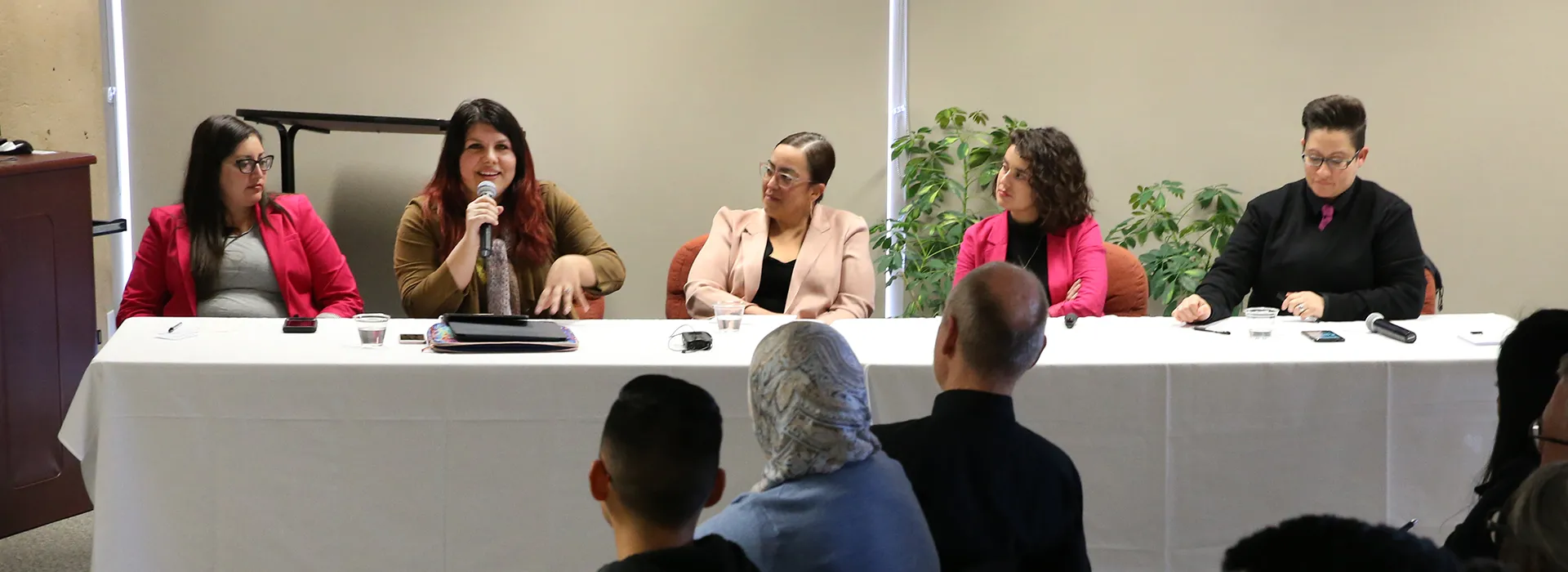Joe Gutierrez Office of Strategic Communication 909-537-5007 joeg@csusb.edu

The Women of Color in Academia group at Cal State San Bernardino hosted a panel discussion on Feb. 6 to highlight the recent works by tenure-track faculty members who are part of the organization. “Today we are here to recognize and celebrate the recent publications of tenure-track faculty members,” said Yvette J. Saavedra, assistant professor of history and co-chair of the Women in Color in Academia group, in her opening remarks. “We hope that in sharing our work and our experiences with you, we are able to add a face to our scholarship. It is no longer just a book or an article in an academic journal, but it gives us an opportunity to show you that this is a labor of love that fuels our roles as teachers, as scholars and as mentors.” The panelists included Nancy Acevedo-Gil, assistant professor of educational leadership; Liliana Conlisk Gallegos, assistant professor of communication studies; Edna Martinez, assistant professor of educational leadership; Isabel Huacuja Alonso, assistant professor of history; and Saavedra. Acevedo-Gil shared her paper, “College-Conocimiento: Toward an Interdisciplinary Understanding of Latina/o/x College Choice,” which proposes college-conocimiento as a framework that contextualizes Latinx student college choices within the inequitable distribution of institutional resources in the K-12 system. “Part of my work focuses on: how do we account for some of this process in a more streamlined experience? Where we can say what is happening in K-12 to inform students that are choosing college to then help them transition on to college,” said Acevedo-Gil, who discussed the difference between aspiration and expectation when it comes to Latina/o students. “This is where some of my work is going – in understanding how do we develop this critical college consciousness for students – that we acknowledge the obstacles they are experiencing throughout this process of college choice and transition.” Conlisk Gallegos discussed her article, “Somos la dignidad rebelde: On Mexican Indigenous praxis of resistance pedagogy, no longer misappropriated under US ‘innovative’ methods,” which focuses on the decolonial tactics of “Rainbow Journalism,” which are simultaneously founded in her transfronteriza experiences, as well as Xicanx, Africana, Feminist, Queer resistance approaches. “I thought: how can we help our undocumented student groups who come here with us, who live with us? How can we show the world that everybody that’s here, that we are behind them, that we are going to protect them, and that we are going to do anything necessary?” said Conlisk Gallegos when describing the ways she came up with the idea of her class, Rainbow Journalism. “And how can I help my students get more experience teaching their colleagues? So I invented this class, and we created a little media conglomerate … we created something we called The Art of Dreaming … and the whole point of that was to create a safe space for us to talk about how we feel.” “Being a student – you are an activist, you are the future, you are the holder of power, you are the one that’s going to dictate the next steps for our society,” she concluded. Martinez presented her study, “The Rules Change: Exploring Faculty Experiences and Work Expectations within a Drifting Community College Context.” “The organizational behavior that I have been studying over the past few years is community colleges that are now offering bachelor’s degrees,” Martinez explained. “The main rationales for community colleges offering bachelor’s degrees are: increasing access to higher education for underrepresented students, meeting unmet state workforce needs, increasing credential requirements for certain careers – such as nursing – protecting students from loss of credit … issues of academic and social integration, and one of the least acknowledged rationales is the desire to increase the prestige – the prestige that comes along with offering a bachelor’s degree … This behavior is variably referred to as academic drift.” Huacuja Alonso explored her work “Radio for the Millions: Hindi-Urdu Broadcasting at the Crossroads of an Empire,” which examines how radio broadcasting contributed to the making and unmaking of borders in modern South Asia. “In pursing this research,” Huacuja Alonso said, “I collected sources including governmental official records, recordings of broadcast radio journals, magazines, memoirs and letters of radio stations, as well as interviewed broadcasters and radio personalities in five countries in three continents.” Saavedra’s book, “Pasadena Before the Roses: Race, Identity, and Land Use in Southern California, 1771-1890,” takes a detailed look at the city’s past beginning with the arrival of the Spanish and establishment of the San Gabriel Mission. “The book itself is about the history of Pasadena – the region that eventually becomes Pasadena – over the course of 150 years, and the main premise of the work is to think about the different competing visions that came into the area,” Saavedra said. “I base it on this idea of optimal land use and how each group that comes in, in the effort of becoming dominant in the area, they brought with them certain ideas of how land should be used … they materialize into different methods of using the land that then is used to create social hierarchies that place some at the top and some at the bottom, and it allows for displacement.” After their presentations, each of the panelists received a certificate of recognition by Assemblymember Eloise Gómez Reyes, who was represented by Esmeralda Vasquez. The Women of Color in Academia, which was established in fall 2016, was created to converge teaching, research and social action, as well as to make a space in which women-of-color faculty can discuss these aspects of their professional careers through an intersectional perspective. For more information about the Women of Color in Academia, contact Yvette J. Saavedra, co-chair of the group, at yvette.saavedra@csusb.edu.